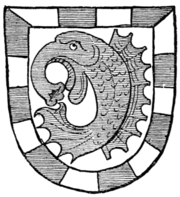by his present Majesty King Edward VII., or the use of separate arms for his Duchy of Cornwall by H.R.H. the Prince of Wales.
Berry is wrong in asserting that no other family were permitted to display the dolphin in France, because a very similar coat (but with the dolphin lifeless) to that of the Dauphin was quartered by the family of La Tour du Pin, who claimed descent from the Dauphins d'Auvergne, another ancient House which originally bore the sovereign title of Dauphin. A dolphin was the charge upon the arms of the Grauff von Dälffin (Fig. 481).
The dolphin upon this shield, as also that in the coat of the Dauphin of France, is neither naiant nor hauriant, but is "embowed," that is, with the tail curved towards the head. But the term "embowed" really signifies nothing further than "bent" in some way, and as a dolphin is never heraldically depicted straight, it is always understood to be and usually is termed "embowed," though it will generally be "naiant embowed" (Fig. 479), or "hauriant embowed" (Fig. 480). The dolphin occurs in the arms of many British families, e.g. in the arms of Ellis, Monypenny, Loder-Symonds, Symonds-Taylor, Fletcher, and Stuart-French.
Woodward states that the dolphin is used as a supporter by the Trevelyans, Burnabys, &c. In this statement he is clearly incorrect, for neither of those families are entitled to or use supporters. But his statement probably originates in the practice which in accordance with the debased ideas of artistic decoration at one period added all sorts of fantastic objects to the edges of a shield for purely decorative (!) purposes. The only instance within my knowledge in which a dolphin figures as a heraldic supporter will be found in the case of the arms of Waterford.

Fig. 481.—Arms of the Grauff von Dälffin lett och in Dalffinat (Count von Dälffin), which also lies in Dauphiné (from Grünenberg's "Book of Arms"): Argent, a dolphin azure within a bordure compony of the first and second.
The Whale is seldom met with in British armory, one of its few appearances being in the arms of Whalley, viz.: "Argent, three whales' heads erased sable."


